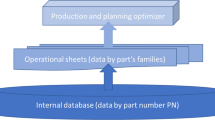Abstract
Concurrent formation of part families and machine cells can be achieved by using various algorithms based on the part-machine matrix. Although, part features form the basis for the formation of the part-machine matrix, part features are not directly considered in the process of forming part families and machine cells. The goal of this paper is to understand the characteristics of machine cells in terms of part features. The relationship between part features and machine cells is captured as a decision tree. The decision tree also becomes a tool for post-clustering analysis including evaluation of different clustering methods and for the classification of ambiguous parts. The simplicity of the decision tree, the number of parts classified by each leaf of the tree, and the effect of pruning on the tree are used as metrics to evaluate the clustering methods.
Similar content being viewed by others
References
J. McAuley, “Machine grouping for efficient production”,Production Engineer,51, pp. 53–57, 1972.
W. T. McCormick, P. J. Schweitzer and T. E. White, “Problem decomposition and data recognition by a clustering technique”,Operations Research,20, pp. 993–1009, 1972.
Y. B. Moon, “Forming part-machine families for cellular manufacturing: a neural network approach”,International Journal of Advanced Manufacturing Technology,5 (4), pp. 278–291, 1990.
Y. B. Moon, “An interactive activation and competition model for machine-part family formation in group technology”,Proceedings of International Joint Conference on Neural Networks (IJCNN), Washington DC, 15–19 January, 1990, vol. 2, pp. 667–670, 1990.
J. R. King, “Machine-component grouping in production flow analysis: an approach using a rank order clustering algorithm”,International Journal of Production Research,18 (2), pp. 212–232, 1980.
M. P. Chandrasekharan and R. Rajagopalan, “Groupability in an analysis of the properties of binary data matrices for group technology”,International Journal of Production Research,27, pp. 399–416, 1989.
C. H. Chu and M. Tsai “A comparison of three array-based clustering techniques for manufacturing cell formation”,International Journal of Production Research,28 (8), pp. 1417–1433, 1990.
J. R. Quinlan, “Induction of decision trees”,Machine Learning,1, pp. 81–106, 1986.
Author information
Authors and Affiliations
Rights and permissions
About this article
Cite this article
Dasari, R.V., Moon, Y.B. Analysis of part families for group technology applications using decision trees. Int J Adv Manuf Technol 13, 116–124 (1997). https://doi.org/10.1007/BF01225758
Issue Date:
DOI: https://doi.org/10.1007/BF01225758




